Comptroller Kevin Lembo Archive > News
COMPTROLLER LEMBO PROJECTS $31.6-MILLION DEFICIT FOR FISCAL YEAR 15In a letter to Gov. Dannel P. Malloy, Lembo said the deficit has receded by $13.2 million from last month's estimate following a notable decrease in General Fund spending growth across all major appropriation line-item categories between October and November.
"In order for the current OPM (Office of Policy and Management) General Fund deficit estimate to be realized, this reduction in the spending growth trend must continue into future months," Lembo wrote. "While there has been some improvement in key economic indicators, current revenue collections do not indicate a positive change to the consensus projections."
The revised deficit estimate this month is mostly attributable to $59 million in deficiency requirements that have been offset by lapse savings of $72.2 million. The majority of deficiency requirements relate to a $40 million shortfall in the Medicaid program, which continues to struggle with federal reimbursement issues and hospital settlement payments above expectations, Lembo said.
The lapse savings increase is primarily the result of a $65-million reduction in debt service payments as the state continues to benefit from ongoing low interest rates, largely due to Federal Reserve policies.
Statewide spending that was initially trending 3 percent above the budget target has been
significantly reduced - and now trending below the original budget, Lembo said. The current projections anticipate that net spending will close the year approximately $25 million below the original appropriated level.
The deficit projection continues to utilize the November consensus revenue forecast report by the Office of Fiscal Analysis and OPM. Lembo said he will watch for any changes to those numbers when OFA and OPM issue an updated report later this month. In the meantime, total General Fund revenue for Fiscal Year 2015 is expected to fall $59.3 million short of initial budget projections. The largest reduction of $61.2 million is tied to federal grants, and approximately $25 million was due to the deferral of Medicaid revenue that Lembo has identified as an area of concern for the past few months.
"As I stated last month, it is imperative that agencies administering federal grant programs provide timely reporting of potential federal claim shortfalls," Lembo said. "The ability to manage the budget is compromised by delayed reporting as was evident in last month's downward federal receipts adjustment."
Lembo highlighted state and national economic indicators from federal and state Departments of Labor and other sources that show:

-
Through the first five months of Fiscal Year 2015, the withholding tax trend was running 3.4 percent above the same period last year. This is a deceleration in the growth rate from last month. The withholding receipts are lagging behind the increasingly favorable employment and wage numbers through November.
Withholding receipts have yet to attain the levels attained prior to the
recession. The large revenue increases in Fiscal Years 2011 and 2012 were almost
entirely attributable to higher income tax rates. Net of those tax increases,
withholding receipts were stagnant in both Fiscal Year 2011 and Fiscal Year
2012. The poor performance also continued through Fiscal Year 2013.
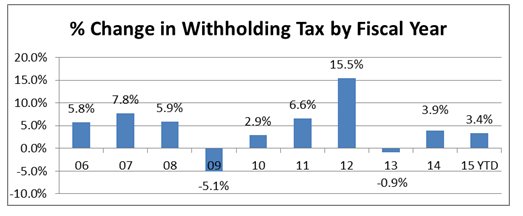
- The graph below depicts the stabilization of job growth in Connecticut going into the second half of Fiscal Year 2014 and continuing in Fiscal Year 2015. The state has gained jobs in nine of the last ten months. November's preliminary gain totaled 4,600 payroll positions.
- . According to the Department of Labor, Connecticut has now recovered 93,200 positions, or 78.3 percent of the 119,100 seasonally adjusted total nonfarm jobs that were lost in the state during the March 2008 - February 2010 recessionary downturn. Connecticut's jobs recovery is now 57 months old and is averaging approximately 1,635 jobs per month overall since February 2010.
- The private sector has restored employment at a quicker pace and has now recovered 97,600 (87.1%) of the 112,000 private sector jobs that were pace recovering 92% of the recessionary job loss. At 1,687,100 overall nonfarm jobs for November of 2014, the state needs to reach the 1,713,000 level to start an official nonfarm employment expansion. This will require an additional 25,900 jobs, which is close to the rate of growth over the past twelve months.
- The table below shows the distribution of employment gains and losses by major employment sector over the latest twelve month period ending in November.
Job additions in Connecticut during this period total 25,700.
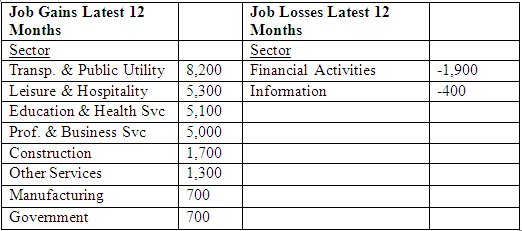
- U.S. employment has been advancing at a rate of 2 percent over the twelve-month period ending in October; Connecticut's employment growth was 1.5 percent for the same period.
- Connecticut's unemployment rate was 6.5 percent in November; the national unemployment rate was 5.8 percent. Connecticut's unemployment rate has continued to decline from a high of 9.5 percent in October 2010.
- There are approximately 122,600 unemployed workers in Connecticut. A low of 36,500 unemployed workers was recorded in October of 2000. The number of unemployed state workers hit a recessionary high of 181,300.
- The Department of Labor calculates that Connecticut's average hourly earnings rose $1.21 or 4.1 percent to $28.81 from November of last year. Average private weekly pay rose to $985.30, up $57.94 or 6.1 percent from November 2013. The state has posted wage gains exceeding inflation (CPI-U 1.3%) over the past two months. This is a reversal of the stagnant wage growth that has been reported over the past two years.
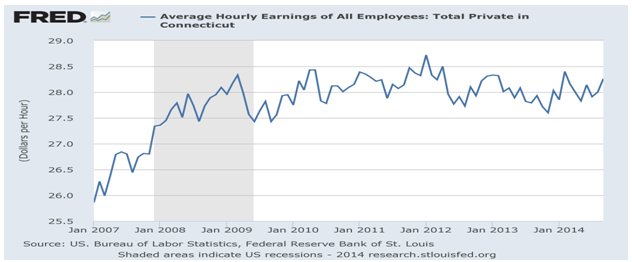
. Based on data released by the Bureau of Economic Analysis on December 19 for
the 3rd quarter of 2014, personal income in Connecticut grew at an annualized
rate of approximately 4 percent down from the 5.2-percent rate of increase in
the 2nd quarter of 2014.Connecticut ranked 18th nationally in personal income
growth for the quarter. Fourth quarter results will be released on March 25,
2015.
. The chart below shows the annual trend in Connecticut personal income over
time. The 2014 estimate is based on annualizing 3rd quarter results.
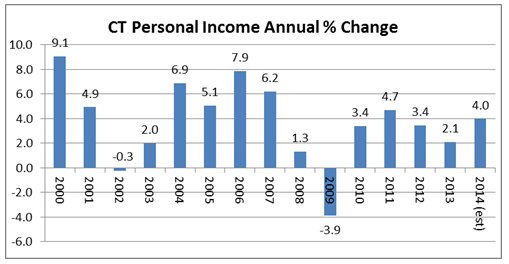

. The Real Estate Conveyance Tax is running 4.7 percent ahead of collections
through October of last year.
. According to a report from the Warren Group released on December 9,
single-family home sales in Connecticut year-to-date thru October of 2014 rose a
robust 7 percent from the same period one year ago. October was the seventh
month in 2014 that posted year-over-year growth in sales.
. The median price of a single family home fell 3.4 percent from October of last
year moving down to $241,600 from $250,000.
. Condominium sales posted 6-percent growth in October, with prices falling 1.2
percent from $172,000 to $170,000.
. The National Association of Realtors reported that existing U.S. home sales in
November were up 2.1 percent from the same month last year, but were down 6.1
percent from October. The Median sale price in October was $205,300, up 5
percent from last year and represents the 33rd consecutive month of price
increase.
Consumers
. Sales tax receipts through November of Fiscal Year 2015 were sluggish after
rising at a year-to-date pace of 4.5 percent through October. At present, the
sales tax is expected to exceed the initial budget projection $48.8 million.
. Advance retail sales were up 5.1 percent in November from last November. Over
the past three months advance retail sales were up 4.7 percent over the same
period last year. Once again auto sales experienced the strongest growth
increasing 9.5 percent over November of last year. Non-store retailers,
electronic & appliance stores, health and personal care stores, and food
services and drinking places all experienced above average growth. Gasoline
stations experienced the strongest sales decline due to falling prices.
. The Federal Reserve reported that consumer credit increased at a seasonally
adjusted annual rate of 4.9 percent in October. This is down from the 3rd
quarter gain of 6.4%. Revolving credit inclusive of credit card debt grew 1.3
percent while non-revolving credit inclusive of car and student loans grew 6.2
percent. Both revolving and non-revolving credit growth is down from 3rd quarter
rates.
Business and Economic Growth
. Based on the December 23 release by the Bureau of Economic Analysis, real GDP
increased at a rate of 5.0 percent in the 3rd quarter of 2014. In the 2nd
quarter of 2014 real GDP increased at a 4.6-percent rate.
. The increase in real GDP in the third quarter primarily reflected positive
contributions from personal consumption expenditures, nonresidential fixed
investment, federal government spending, exports, state and local government
spending, and residential fixed investment. Imports, which are a subtraction in
the calculation of GDP, decreased.
. The acceleration in the percent change in real GDP reflected a downturn in
imports, an upturn in federal government spending, and an acceleration in
personal consumption expenditures that were partly offset by a downturn in
private inventory investment and decelerations in exports, in state and local
government spending, in residential fixed investment, and in nonresidential
fixed investment.
. In the 3nd quarter, U.S. corporate profits posted a 3.1-percent gain from the
3rd quarter. The 2nd quarter had posted a stronger 8.4% rise in profits. Profits
were up 1.4 percent from the 3rd quarter one year ago.
. The Department of Labor's General Drift Indicators are composite measures of
the four-quarter change in three coincident (Connecticut Manufacturing
Production Index, nonfarm employment, and real personal income) and four leading
(housing permits, manufacturing average weekly hours, Hartford help-wanted
advertising, and initial unemployment claims) economic variables, and are
indexed so 1986 = 100. The index has been showing a general upward trend.

. Estimated income tax payments increased at a 5.1-percent rate on a
year-to-date basis through November inclusive of accruals.
. At this writing, over the past twelve months the DOW has advanced 9.05 percent
. On a year-to-date basis the Dow is up 8.64 percent.
DOW
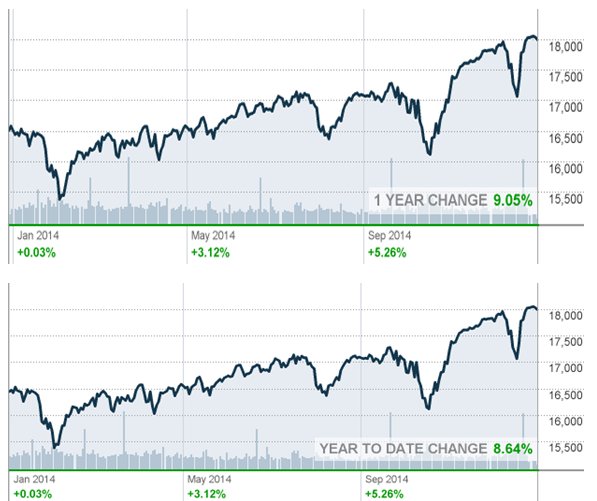
***END***
